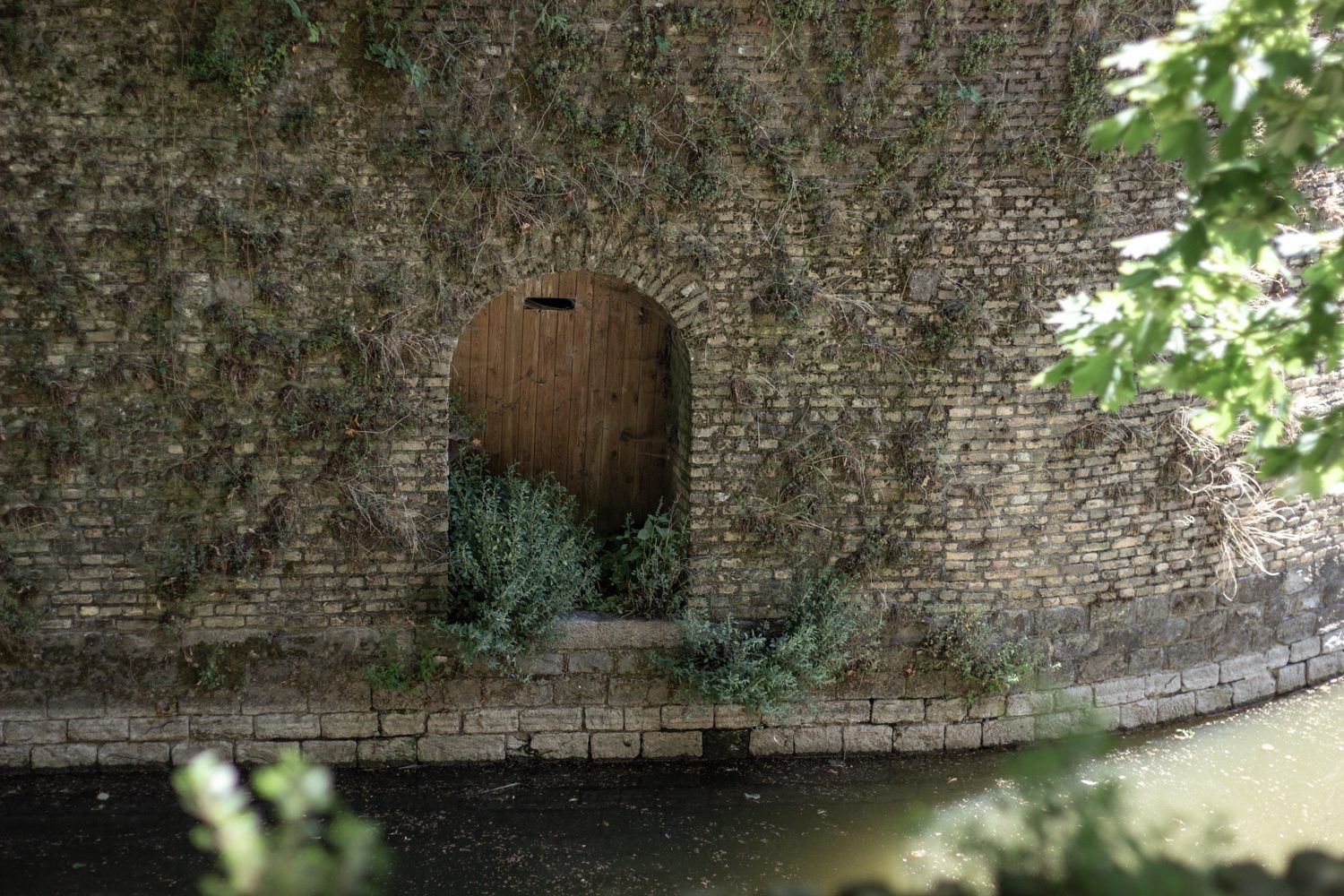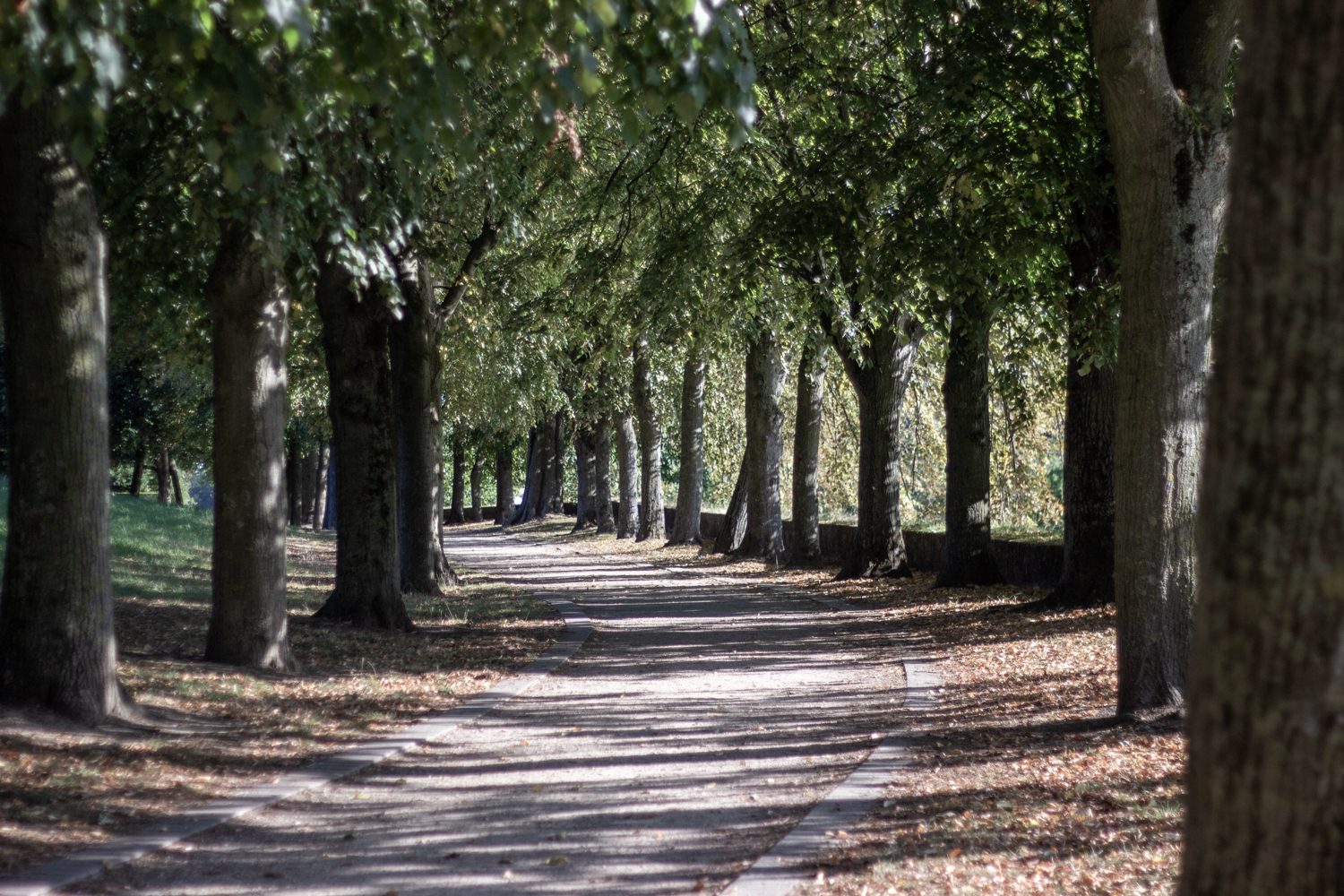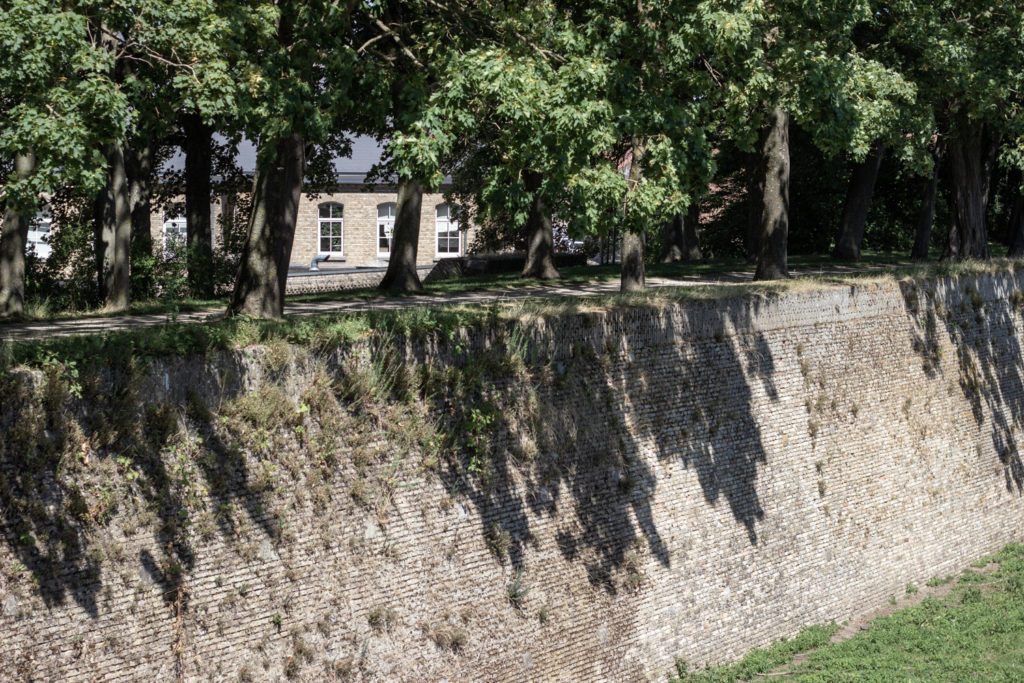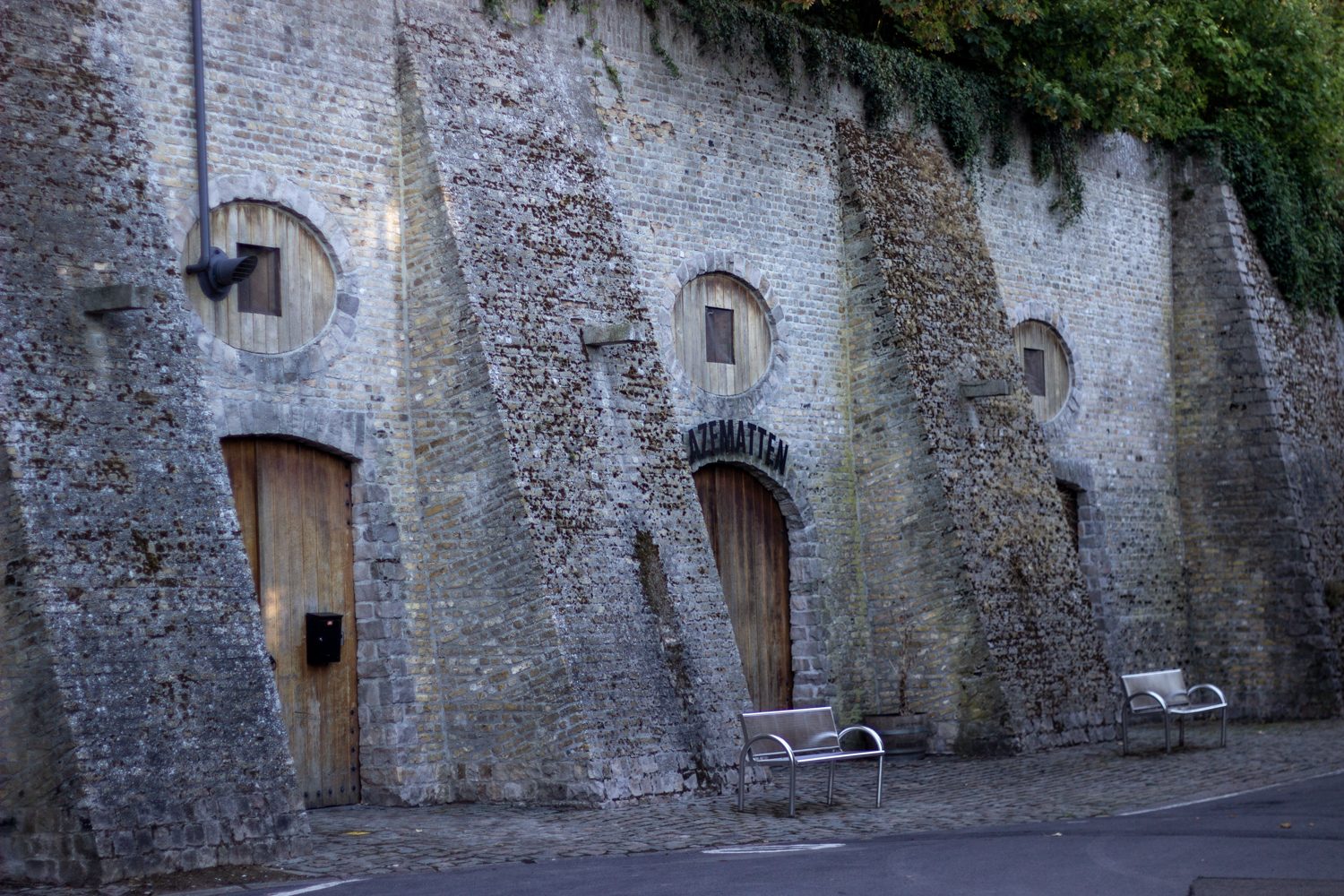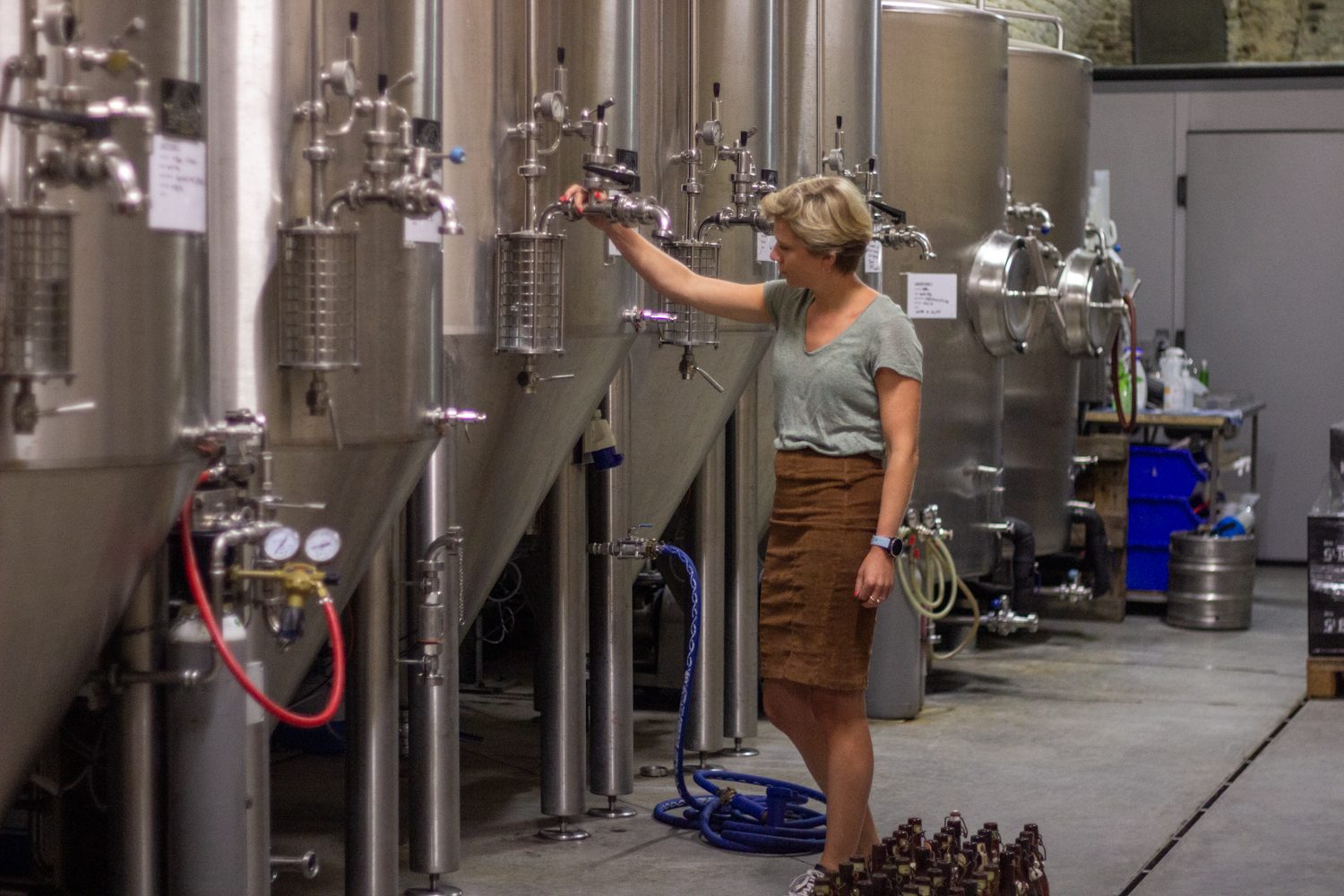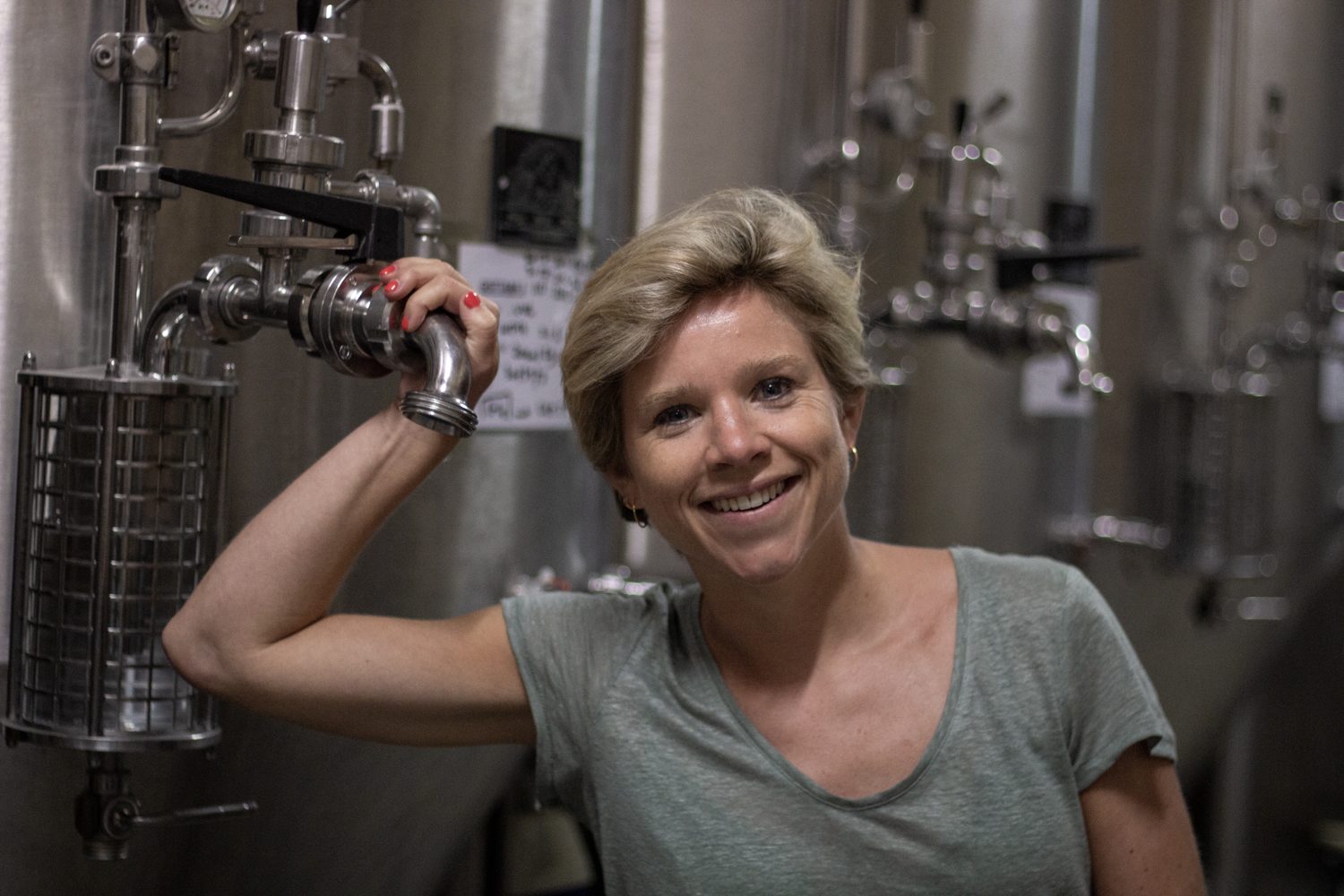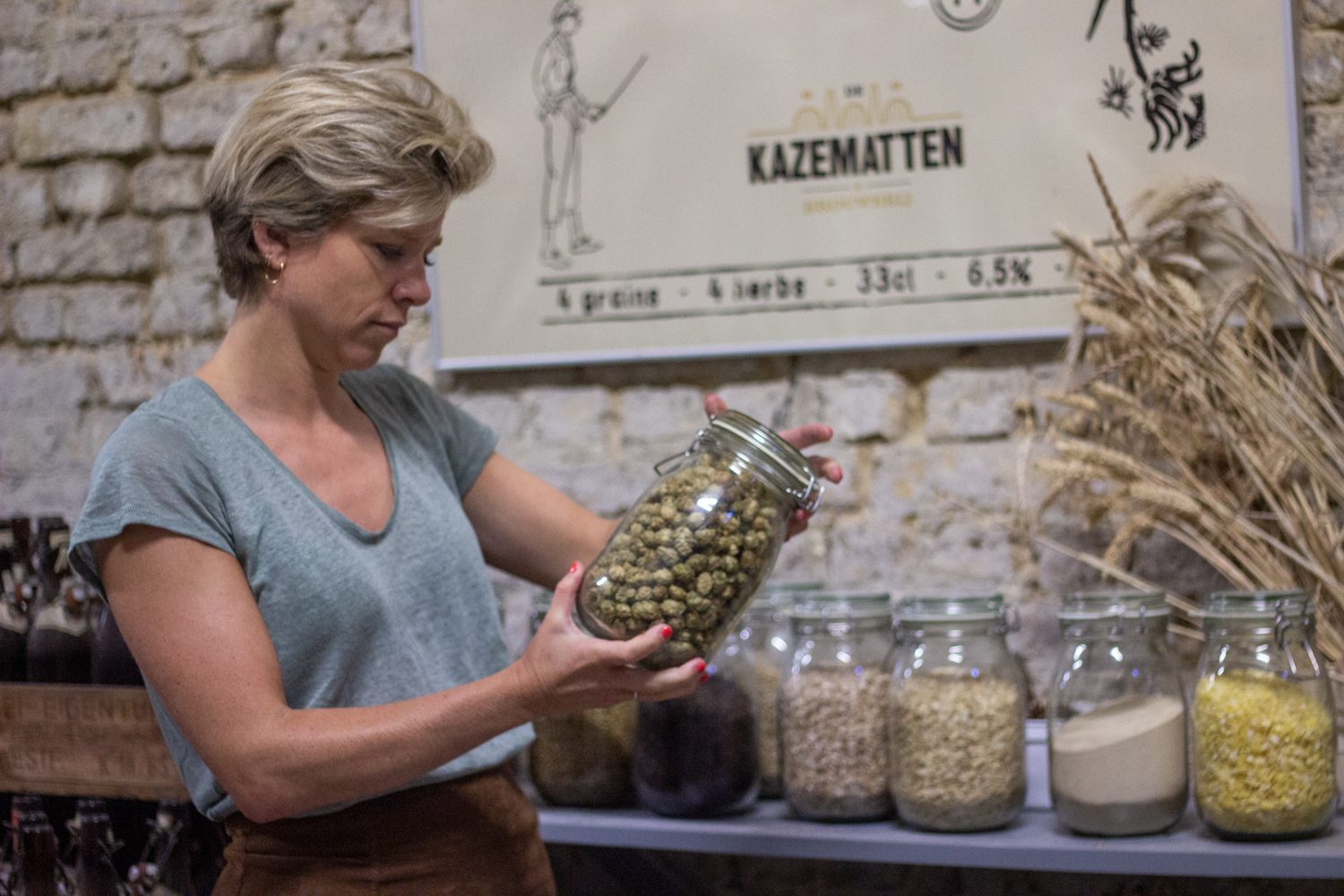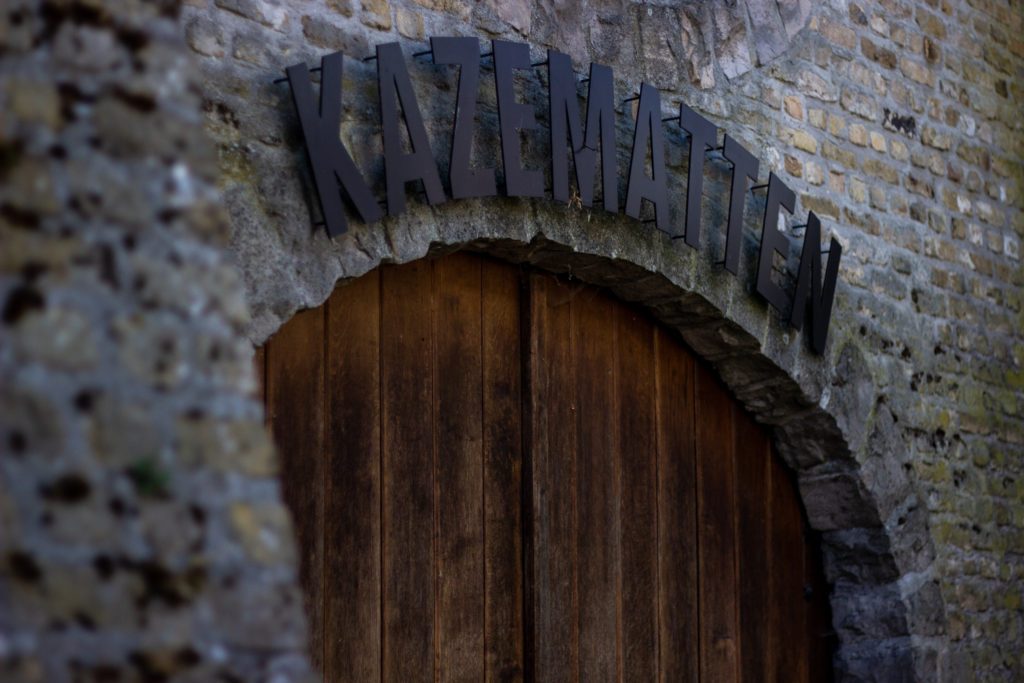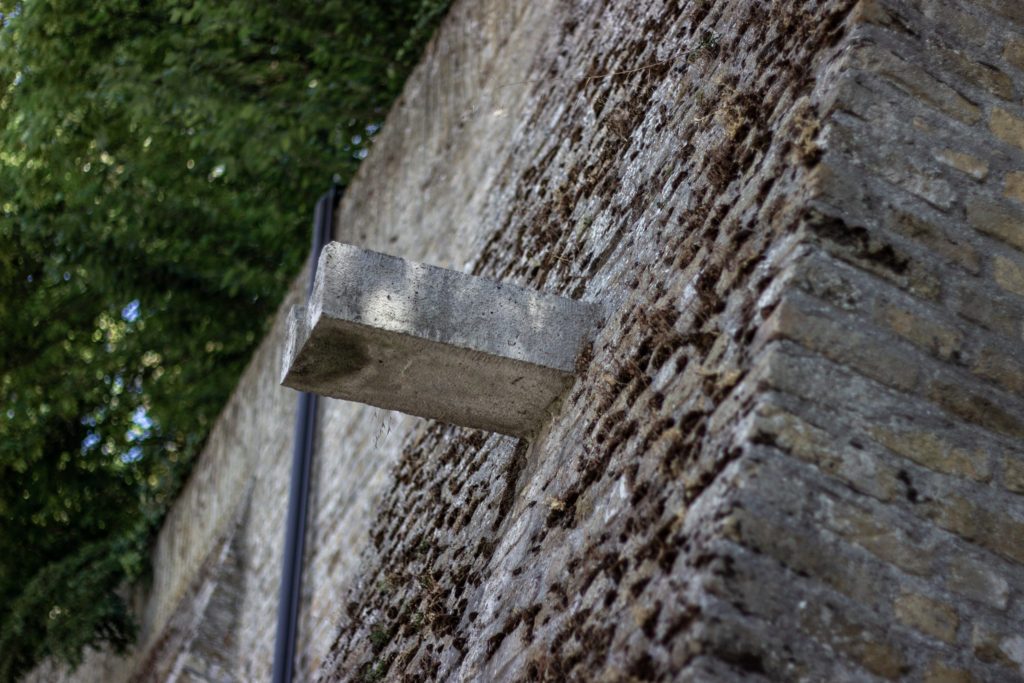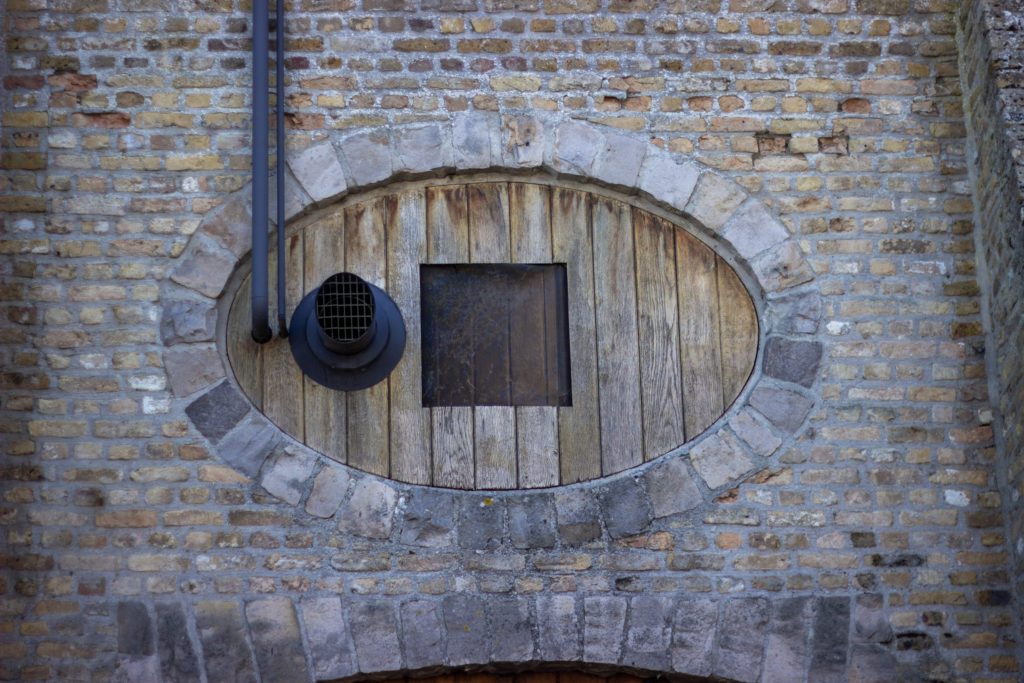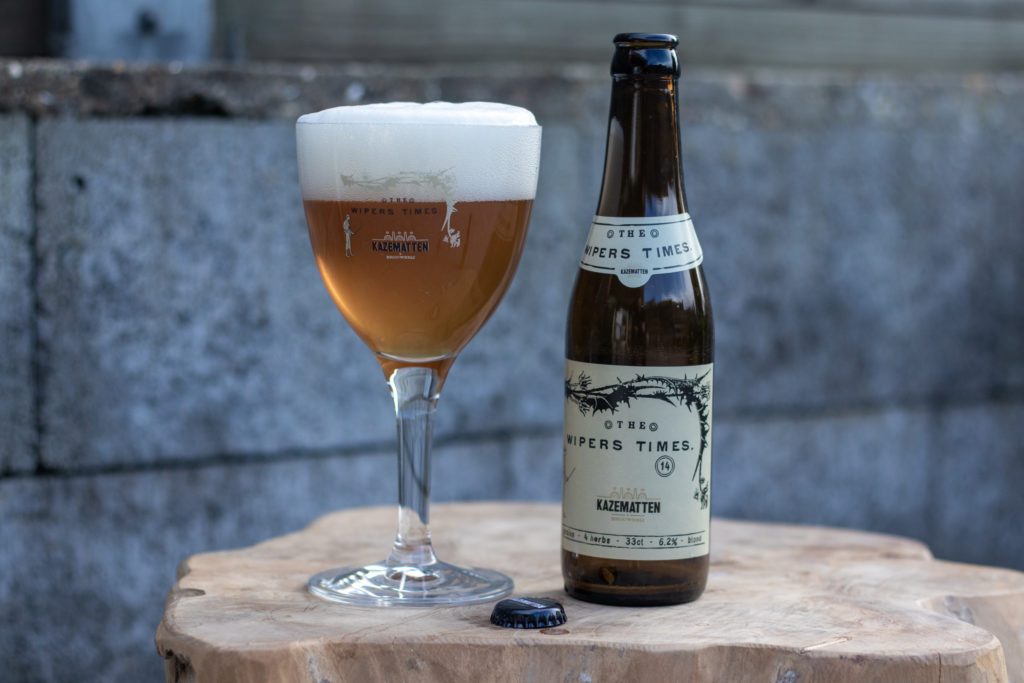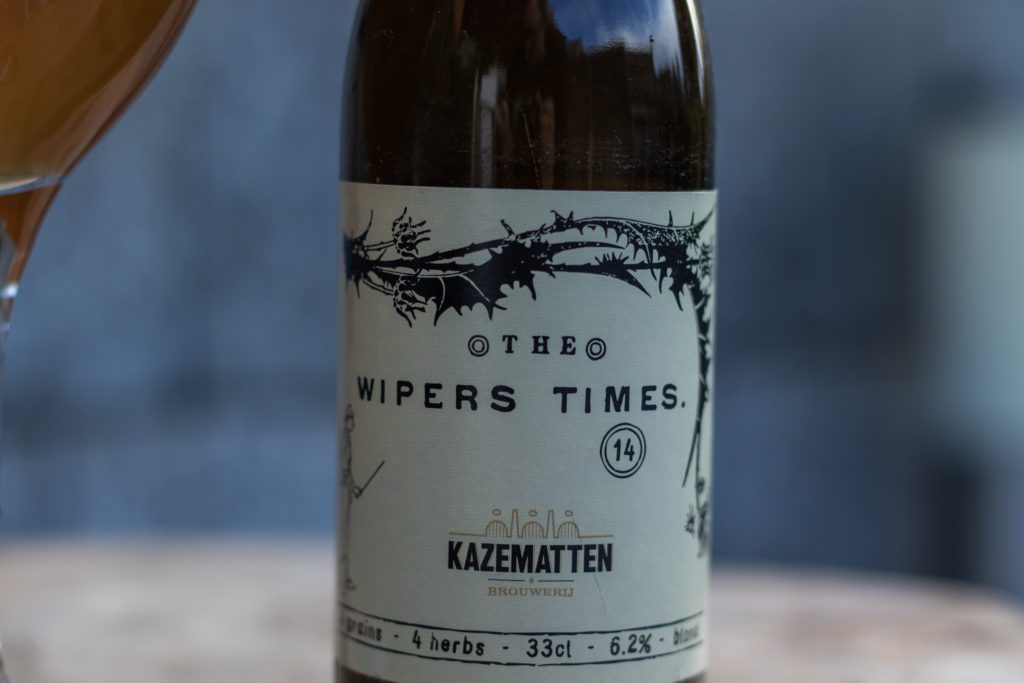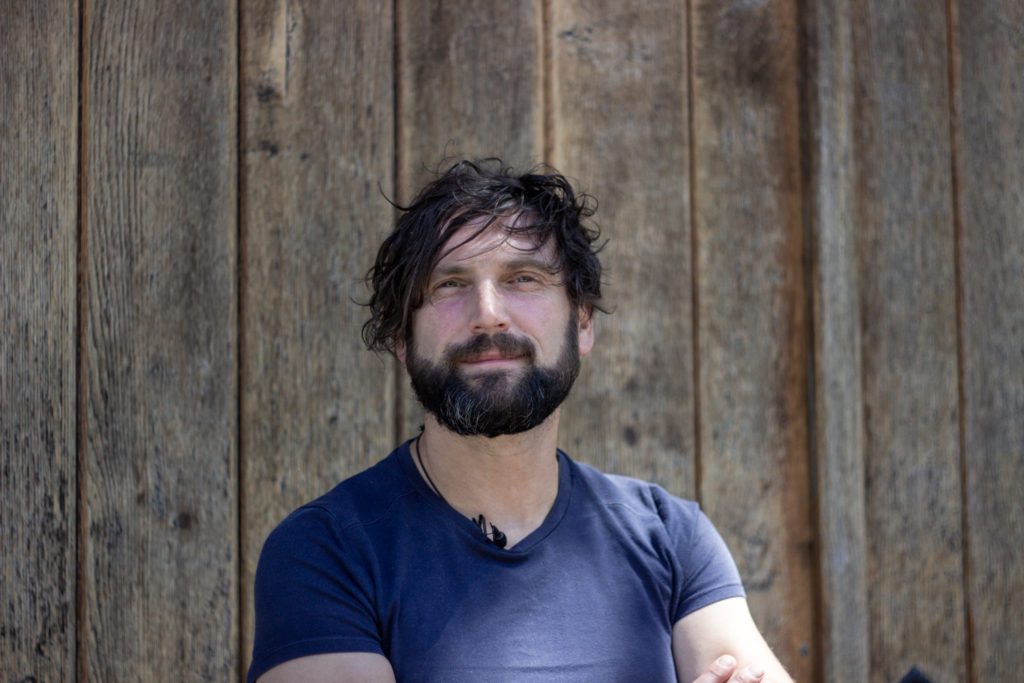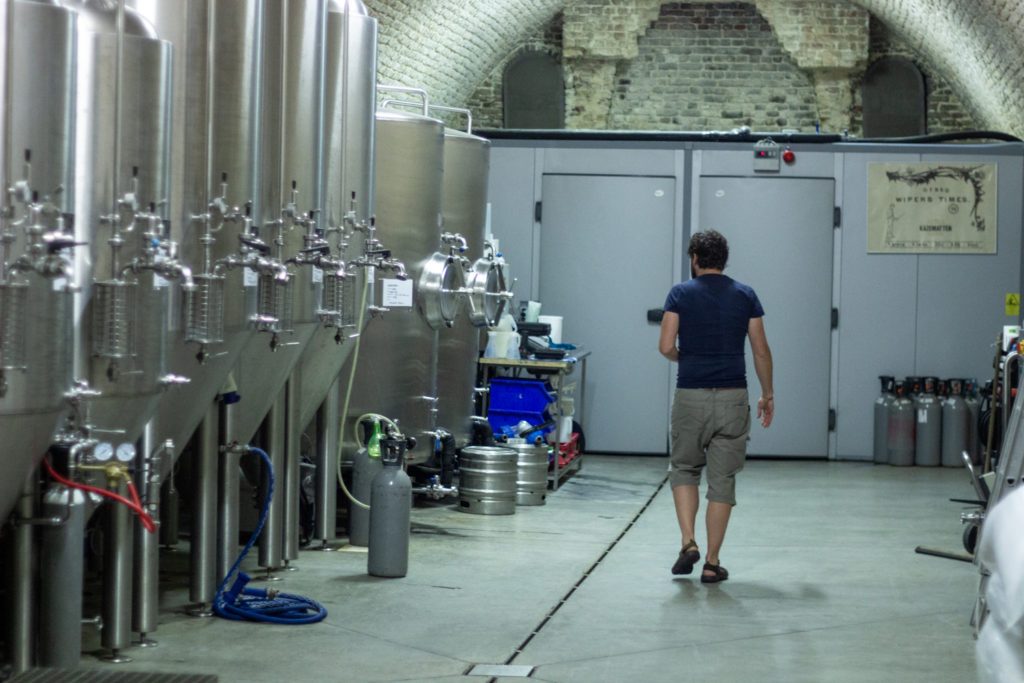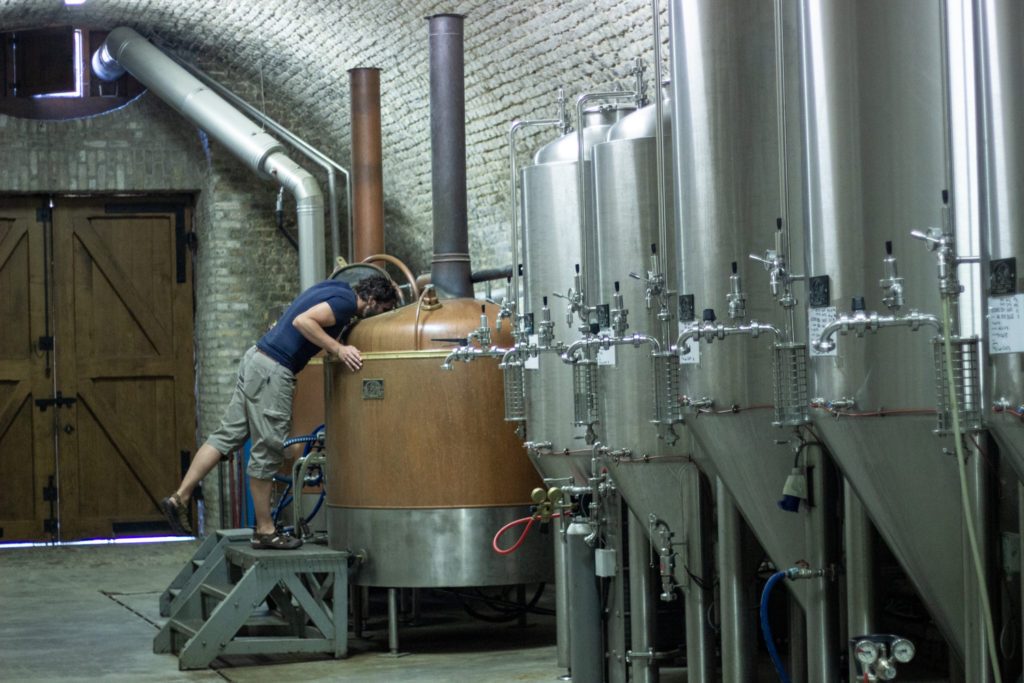Words by Breandán Kearney
Photos by Breandán Kearney & Sophie Callewaert
Edited by Oisín Kearney & Ciara Elizabeth Smyth
This editorially independent story has been supported by VISITFLANDERS as part of the “War Chest” series. Read more.
On the face of it, there is little remarkable about the Kazematten brewery. It opened in 2013, just as the city of Ieper was preparing for its four-year-long centenary commemorations of the First World War. Although its output is modest—around 750 hectolitres per year of classic Belgian ales—the brewery has won medals at both the Brussels Beer Challenge and the World Beer Awards.
The deeper you move into the Kazematten, the more compelling its story becomes. The brewery is housed in one of the most unique spaces of any brewery in the country: cave-like casemates of cold grey stone peppered with medieval armaments and First World War bullet holes. It was the first brewery to open in Ieper since 1976, effectively making its products the de facto beer of the city when it launched. Most notably, the brewery represents the coming together of two prominent families in Belgian beer: the Ghequires and the Depyperes. Kazematten is a side project which has given the members of those two families a way to each chase what was missing in their lives. They did all this with the help of a clown.
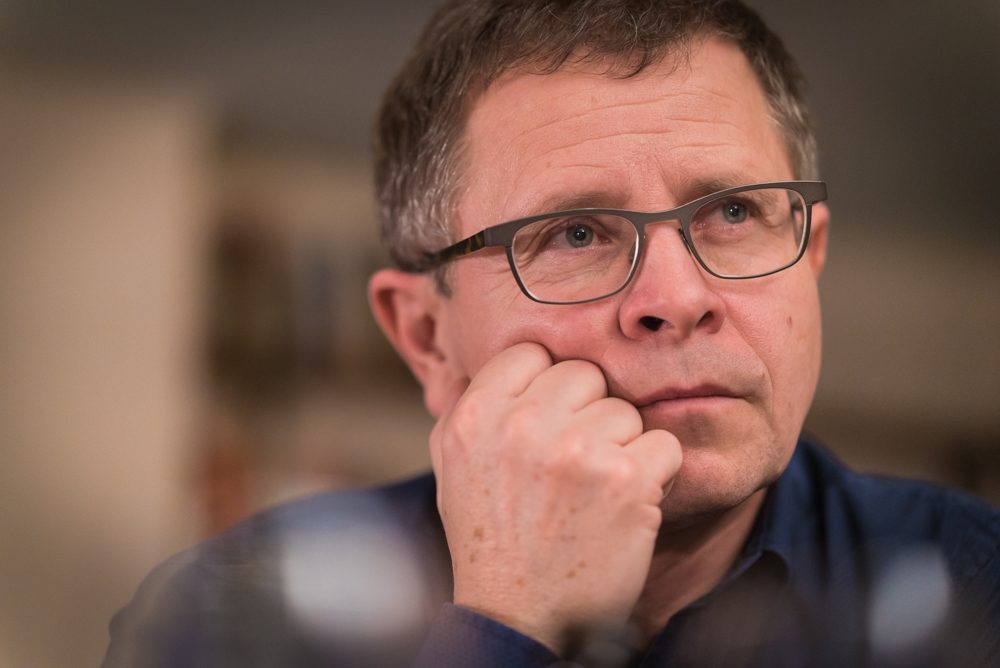
For as long as he can remember, Rudi Ghequire has walked along the ramparts of Ieper, a huge complex of walls, islands, and fortifications which were created in the seventeenth century by French military engineer Sébastien Le Prestre de Vauban. First he walked them when he was a child, having grown up on a farm just outside Ieper, and more recently on walks with his wife Marijke at weekends.
Rudi’s job title is Site Manager at Brouwerij Rodenbach, the largest producer of Flemish Red Brown beer in the world and an institution of a brewery which existed before the creation of Belgium as a country. Rudi has worked at Rodenbach since 1982 and has become somewhat of an institution himself, respected nationally and internationally for his knowledge and strength of will.
Rudi loved his job, and was proud to be the Rodenbach guy. He wanted to continue in that role for years to come. But he also wanted to take on other challenges, one of which was to own his own small brewery so that he could have fun with developing new beers, and tell an original story about the place where he had grown up.
On one of his walks around the ramparts with Marijke in 2010, Rudi came to an area above a street called the “Houten Paard” or “Wooden Horse”. The views here are particularly pleasing on the eye, a green-blue garland of natural park which kisses the historic city centre of Ieper on one side and stands tall above a wide moat on the other.
Curious about what was at street level, Rudi descended and saw three large wooden doors and a lifesize statue of half a horse, a reference to a military punishment tool that was used in the city during the Middle Ages and which gives the street its name. The wooden punishment horse had a sharp, pointed back on which the punished soldier was forced to sit, their feet weighted with bags of sand. Behind the three large doors Rudi saw were three casemates: interconnected underground corridors each 30 metres long and 6 metres wide.
When Rudi enquired about the Houten Paard casemates, he discovered that they were used only for winter storage of terrace tables, chairs, and parasols by local bars and restaurants. City officials were keen that someone with the profile of Rudi Ghequire might transform the casemates and indicated their interest in leasing the space. For them, it would represent a significant opportunity for tourist experiences.
Rudi discussed the possibility of opening a small brewery with his son, Maarten Ghequire, a bio-engineer who had completed his master thesis at the Centre for Malting and Brewing. Through their discussions, Rudi and Maarten realised that they would not be able to do it alone. Rudi’s role at Rodenbach was demanding, and Maarten was busy as a postdoctoral researcher at KU Leuven’s Faculty of Engineering Science. If they were to embark on this side project, they’d need assistance and expertise in production, packaging, logistics, sales, distribution, and finance. Without the right partner, their brewery project would remain a pipe dream.
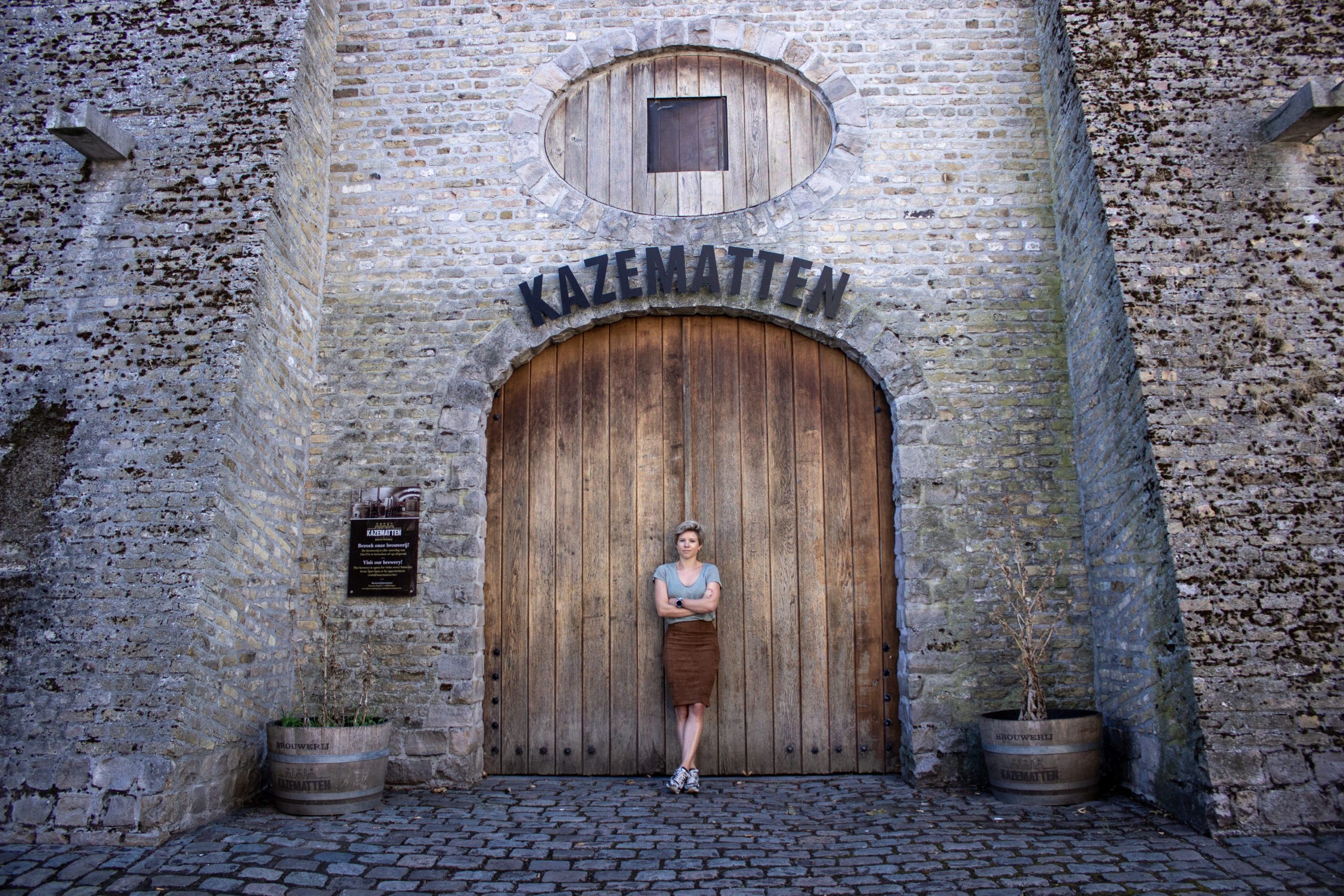
Julie Depypere and her husband Peter Sagaert moved into a rural property in the Walloon village of Leers-Nord across the language border from Flanders where she had grown up. Pierre was a cattle farmer and the property was ideal for grazing cows. It had plenty of space for their three active young children, Hélène, Armand, and Renée. There was a large white barn on the property with a red-tiled roof. A name hung above the entrance to the barn: “La ferme de la motterie”. The building was listed as protected national heritage. Julie enjoyed family days out and took her children to Kortrijk to see clown shows at the first holy communion parties of her children’s friends. Renée was delighted when Julie invited the same clown performer to their property for her communion party.
Julie worked at her father’s company, a brewery in Watou called Sint Bernardus. Before then, Julie had worked as an auditor at PriceWaterhouseCoopers in Ghent. She had seen how firms booked things into different accounts. She observed how they reported warehouse inventories. She learned to read Profit and Loss statements. “You get a helicopter view of the firm,” she says of her auditing work. “In two days, you should know the firm from A to Z.” After that, Julie had taken up a position as Controller at Compo in 2007, and then became Head of Accounting of IVC Belgium in 2009.
In 2011, seeing that Julie was developing a skill set missing at the brewery, Marco Passarella, Sint Bernardus’ Sales Manager and a confidant to Julie’s father Hans Depypere, asked Julie to come in as assistant to the in-house bookkeeper. It was a role for which she was overqualified. But she knew her father would want her to prove herself and work her way up in the family business. “From the first day on, I adored it,” she says.
Hans Depypere had built up his family’s electronic alarm system business in the United States—Julie was born in Newport Beach, California in 1982—and then sold it in 1998 before buying a small brewery, Sint Bernardus, which had existed since 1946. Back then, Sint Bernardus was producing only 8,000 HL of beer per year. By the time Julie started there, the brewery was producing 33,000 HL per year.
Gradually, Julie began implementing operational changes which would improve how Sint Bernardus did business. At first, Hans was anxious, concerned with changes he did not understand. While Hans was representing Sint Bernardus at events and festivals, Julie took on more and more operational responsibility within the company. “In the beginning he didn’t get it,” says Julie. “He sometimes thought, like, ‘she’s taking my place’. And I was like, ‘no, no, no, not at all’. I don’t want to be the face of Brewery Sint Bernardus. I’m just good as I am. It’s perfect as it is right now.”
Julie set up enterprise resource planning to manage and align different parts of the Sint Bernardus business, from production to HR to accounting. She introduced optimisations in the reservation system for brewery visits. She introduced an Optical Character Reader so that the thousands of order forms and invoices they were working with each year were automatically scanned and searchable. “If you want to keep your firm, you should invest in innovation, R&D, and software,” says Julie. “You should always have the latest things.”
Hans Depypere was an old-school businessman with little experience of I.T. but he quickly began to see benefits from the changes implemented by his daughter. Hans soon came to realise that his daughter was future-proofing the family business. To show her that he believed she was ready for more responsibility, Hans approached Julie about owning and managing her own brewery as a side project.
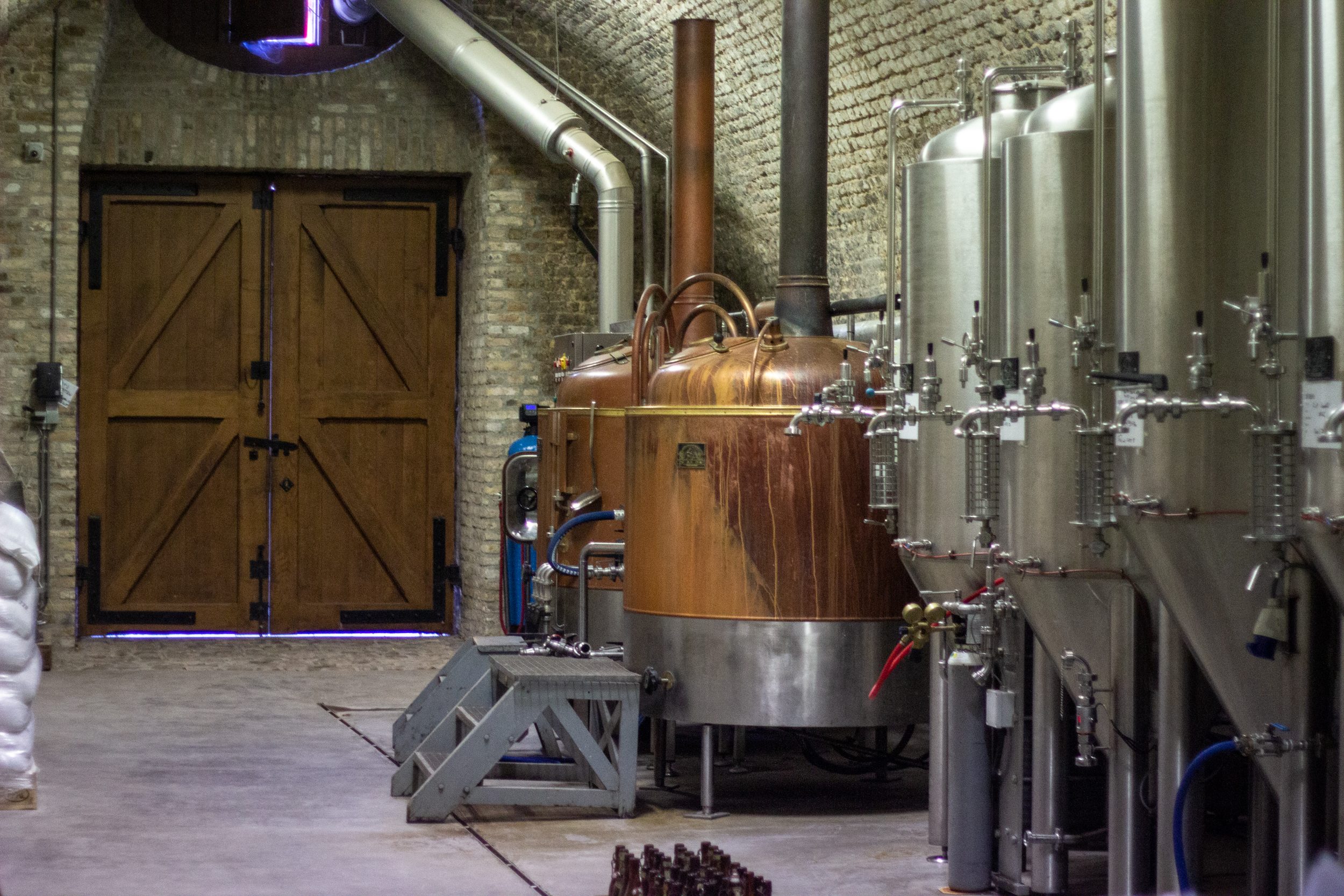
The plan was to install the new brewery in the barn on the property where Julie lived in Leers-Nord with her family. Hans had even sourced a small brewing system, a 600 litre kit with a stainless steel interior and copper jacket manufactured in Italy by now defunct Belgian company SBM, which was owned by a former CEO of Duvel Moortgat. The SBM kit had originally been used between 1996 and 2008 by Jan Vanhie and Caroline Cokelare at their brewpub, the Old Bailey, on the church square of Sint Eloois-Winkel, and had been quite the draw given its old-world aesthetics.
Julie Depypere was excited to embark on a new project with her father. “We are complimentary,” she says of her relationship with Hans Depypere. “In fact, we really, really work good with each other.” But she was hesitant about setting up a brewery in her barn. Her husband Pierre wanted to use it for his cattle. If they could find a location that was completely unique, one with its own story to tell, then it might be something she could throw herself into with her father. The Depyperes continued their search.
Rudi Ghequire and Hans Depypere were both part of the Royal Brewers Guild of Kortrijk. They had met each other and exchanged pleasantries at previous meetings but it was on a guild excursion to France in 2011 that they revealed their respective plans to open a small brewery with their children. Rudi told Hans about the Houten Paard casemates. Hans told Rudi about the SBM brewing system. They agreed to have a further meeting when they returned to Belgium and soon two influential families in Belgian beer—the Ghequires and the Depyperes—were at work meeting with the Mayor of Ieper and formulating a business plan. Both families decided that the official owners of the new brewery would be the new generation: Maarten Ghequire and Julie Depypere.
Rudi and his son Maarten got to work preparing the space for production and re-engineering the brewing system to maximise it for use in the casemates. They arranged for gas, electricity, and sewerage in the casemates. They facilitated the de-ionising of their brewing water so they could add brewing salts as desired. They installed a steam generator to heat the brewhouse, and glycol lines to cool their lagering beer. As breweries go, Kazematten would be small, compact, and manual, but it would be capable of producing high quality beer.
Next, they needed an identity for the brewery and beers. With the research assistance of Sint Bernardus Sales Manager, Marco Passarella, and the curator of the Hooge Crater museum in Ieper, Niek Benoot, the Ghequires and Depyperes discovered that the casemates at the Houten Paard had enjoyed a rich history.
During the First World War, the casemates were used by British troops as a command post, field hospital, shelter, and dormitory. There were unconfirmed stories that the casemates were also used as incubation chambers for growing mushrooms, cellars for maturing cheese, and spaces for storing ice. But the fact that grabbed Passarella and Benoot the most was that the casemates had been a printing office for a satirical trench newspaper published by members of the British army who were stationed on the front line along the Ypres Salient during the First World War.
A battalion known as the Sherwood Foresters had come across an abandoned printing press while looking for material in Ieper to shore up the trenches. Captain Fred Roberts and Lieutenant Jack Pearson—with the help of a Sergeant Harris, who had worked as a Fleet Street printer in peacetime—salvaged the printing press and started a newspaper to lift the spirits of soldiers stationed in Belgium.
The paper they produced—The Wipers Times—was named after their slang pronunciation of the city’s name in French, “Ypres”. The Ghequires and the Depyperes decided that the brewery should be named after the casemates in which it would be housed—“Brouwerij Kazematten”—and that the first beer would be called “Wipers Times” to honour the casemates’ previous use.
Wipers Times 14 would be a Belgian Blonde Ale of 6.2% ABV. The “14” would refer to the original density of sugars in the beer pre-fermentation (14 degrees plato) and it would ferment down to a resting plato of 2.5°P. It would be produced using four grains: barley, wheat, oats, and corn. Two classic Belgian hop varieties would be used; one for bittering, one for aroma. It would have a herbal and spicy profile, partly because of the yeast’s peppery character, and partly due to additions of, among others, coriander, bitter orange peel, and the seeds of blessed thistle.
Blessed thistle is a bitter flower which is commonly used in extracts and cordials and is thought to have properties as a digestive stimulant and nutritive tonic. It was chosen because blessed thistle appeared as an illustrative masthead on every edition of the Wipers Times newspaper, intended by the Sherwood Foresters to demonstrate the “prickly” nature of the humour in its pages. Blessed thistle was planted in two half-barrels at the doors to the casemates at Houten Paard when Brouwerij Kazematten launched.
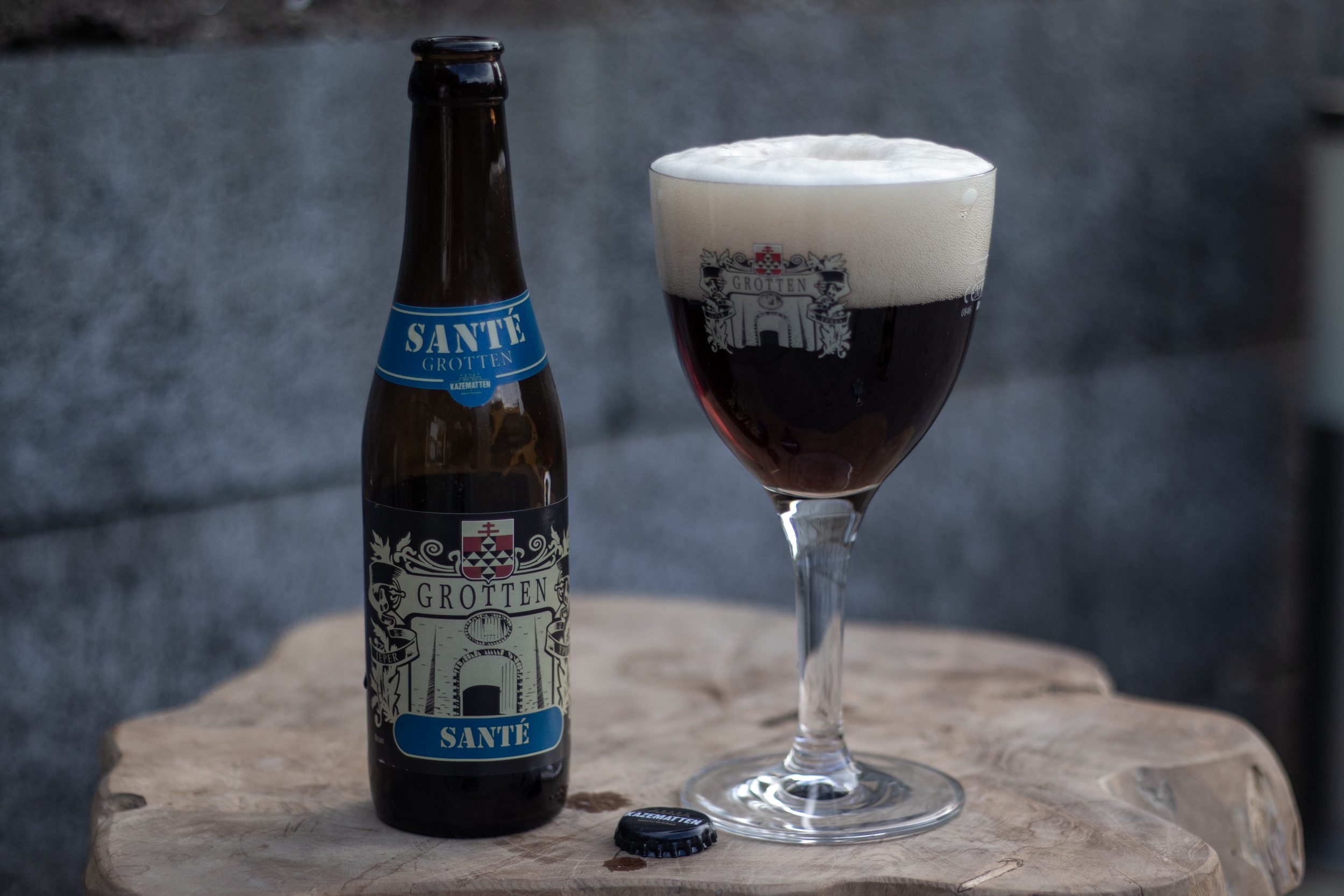
The Ghequires and Depyperes would also brew Grotten Santé, a spiced Belgian Brown Ale of 6.5% ABV—“Grotten” translates from Dutch to English as “Caves”. Grotten Santé was a beer brand and recipe that Hans Depypere had acquired from another Belgian brewer, but which he had not produced previously at Sint Bernardus. It was originally created by Pierre Celis, the iconic Belgian brewer who created Hoegaarden in the 1960s. Celis sold the brand and recipe for “Grottenbier” to Hans Depypere after Celis helped Hans develop the Belgian wheat ale, Sint Bernardus Wit.
The Ghequires and the Depyperes had the SBM brewery system. They had the unique location in the casemates, a production space unlike any other in Belgium. They had the recipes and brand identity of two beers they wanted to brew. But, like the Wipers Times newspaper for the soldiers fighting in WWI, it was still everyone’s side project. Rudi Ghequire was managing Rodenbach, Maarten Ghequire was pursuing his PhD, and Hans and Julie Depypere were running Sint Bernardus.
If they were to execute on their plan, they’d have to find someone to carry out the day-to-day brewing and cellar work at the Kazematten. The person would need to be a qualified brewer willing to brew only twice a week, carry out all lab work and cellaring, assist with packaging and administration, and even help out hosting visitors. It would preferably be someone they already knew. Without the right person, the Kazematten would fail before it started, and the reputations of each of the Ghequire and Depypere families might be blemished in Belgium forever.
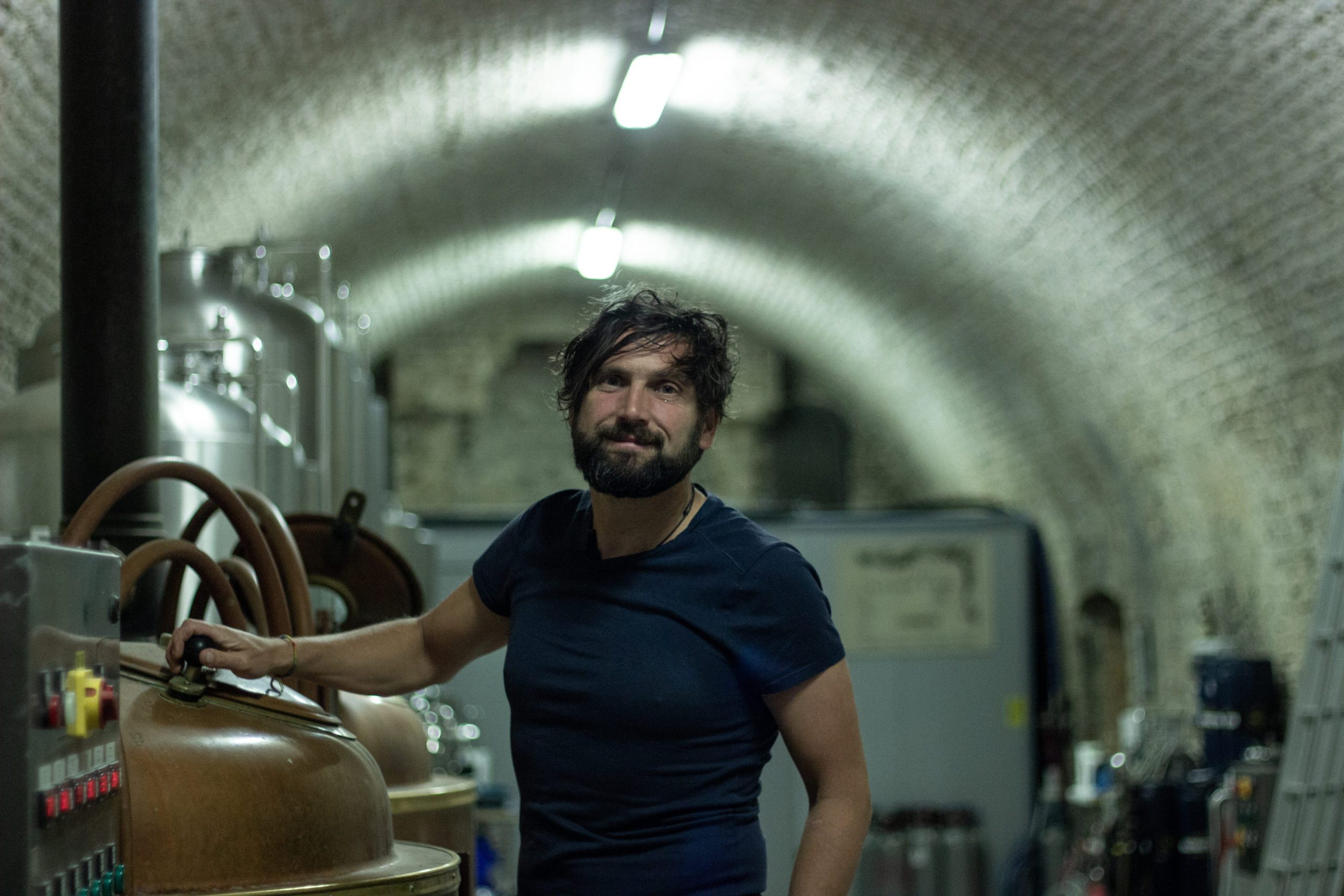
In 2006, Koen Hugelier, thirty-years-old, quit his job as a lab technician to become a full-time professional clown. He had been clowning on a part-time basis since 1998, working as a medical and pharmaceutical laboratory technician at Ghent University to pay the bills. He called himself “De Clown”.
Koen’s clowning talent was diverse: balloon sculpting; juggling and diablo art; stilt walking; magic tricks and visual gags; and entertaining with puppets such as Minky, the acrobatic raccoon. His outfit was not that of the Carnival Clown but rather a more understated costume, most often wearing pinstripe trousers, waistcoat, and tailcoat, and adorning a tiny clip-on red nose, his cheeks powdered with red blusher.“I don’t have red hair,” says Koen. “I don’t have much make-up. I don’t have big shoes. I’m just like I am.” Koen clowned at local village fêtes, electronic dance festivals, company events, and sports clubs. He clowned at first holy communion parties in Kortrijk. “Sooner or later [people] notice that I’m always wearing two different colours of shoes,” he says. Clowning was Koen’s passion and he pursued it fully.
Despite his career change, he retained an interest in biochemistry, and curious about fermentation in particular, Koen signed up for a two year Zytholoog course in 2008 at Syntra West in Kortrijk, a course to become a “beer sommelier”. Modules went into details on beer styles, brewing process and ingredients, tasting and flavour science, and beer and food pairing. One of Koen’s teachers on the course turned out to be the Site Manager at Brouwerij Rodenbach, Rudi Ghequire, one of the most well known people in the Belgian beer industry.
When Koen’s daughter Soete was born in 2010, Koen decided to celebrate by brewing a beer for the occasion. At his local brewery in Gullegem, De Gulden Spoor, brewery owner Björn Desmadryl helped him brew 1,000 litres of Luxuria (9% ABV), a kind of Belgian Strong Dark Ale meets Stout meets Belgian Scotch Ale. Koen poured some of it at parties and sold the rest. He enjoyed the experience so much that he took some freelance work brewing at De Gulden Spoor and then at another facility which Björn Desmadryl set up in Heule called the Brew Society. Koen continued producing small amounts of Luxuria there, as well as new beers such as Belgian Strong Dark Ale, Gula (10% ABV) and Imperial Stout, Invidia (10% ABV), branding them together under the banner “Zeven Zonden” (“Seven Sins”) and selling them through his new company Hugel.
But Koen never wanted to manage a brewery or make the production of Hugel beers his full-time occupation. “I’m not very good in commercial [matters],” he says. “I’m only good in brewing [matters].” He wanted to drive brewhouses more often, but part-time freelance brewing gigs in Belgium were few and far between. If he was to seek out a job as a brewer full-time, he might not have time to continue his clowning.
Koen enjoyed the two year Zytholoog course so much that, after having already completed it, he signed up to do it again. The course administrators suggested that he might become an assistant to the teachers instead. After a year as an assistant, Rudi Ghequire stopped teaching due to a range of other commitments at the Rodenbach Brewery and, impressed by Koen’s performance with students, the administrators at Syntra West asked Koen to teach the class on his own. At the end-of-year student assessment evening, Koen’s students had to present food and beer pairings to a range of “judges”, one of whom was Rudi Ghequire. Remembering Koen as a student and assistant teacher, he was interested to learn Koen had been brewing on a freelance basis at De Gulden Spoor and the Brew Society. Rudi asked Koen to meet him the following week to discuss a project on which he was working.
At the meeting, Rudi told Koen the project was a new brewery called Brouwerij Kazematten which would be located in one of the casemates of Ieper and asked if he would brew there part-time. He would work closely with Rudi in production, take visitors on tours, and keep Julie Depypere informed of administrative and management issues.
On 14 September 2013, Koen Hugelier and Rudi Ghequire brewed together for the first time. It was the inaugural batch of Wipers Times 14. Everything went right. There was no stuck sparge. The pair hit all their targets for gravity, temperatures, and brew efficiency. The wort began fermenting vigourously the next morning. The pair worked well together as a team throughout the brew. Creating something new and full of pride, Rudi Ghequire describes it as “one of my luckiest days ever as a brewer.” Koen has brewed every single drop of Kazematten beer since then. “I enjoy it a lot,” says Koen. “And this location is wonderful.”
Koen brews at the Kazematten on Thursdays and Fridays, combining it with brews at the Brew Society in Heule on Mondays and Tuesdays, Zytholoog teaching on weekday evenings, and clowning gigs at the weekends. On some days he has to combine his passions and pops into the brewery to check on the tanks straight after a clowning gig, without changing his costume or cleaning the make-up from his face. It’s the reason why on visits to Brouwerij Kazematten, you might see tiny fragments of glitter, sparkling incongruously against the dark grey walls of these impressive underground chambers.
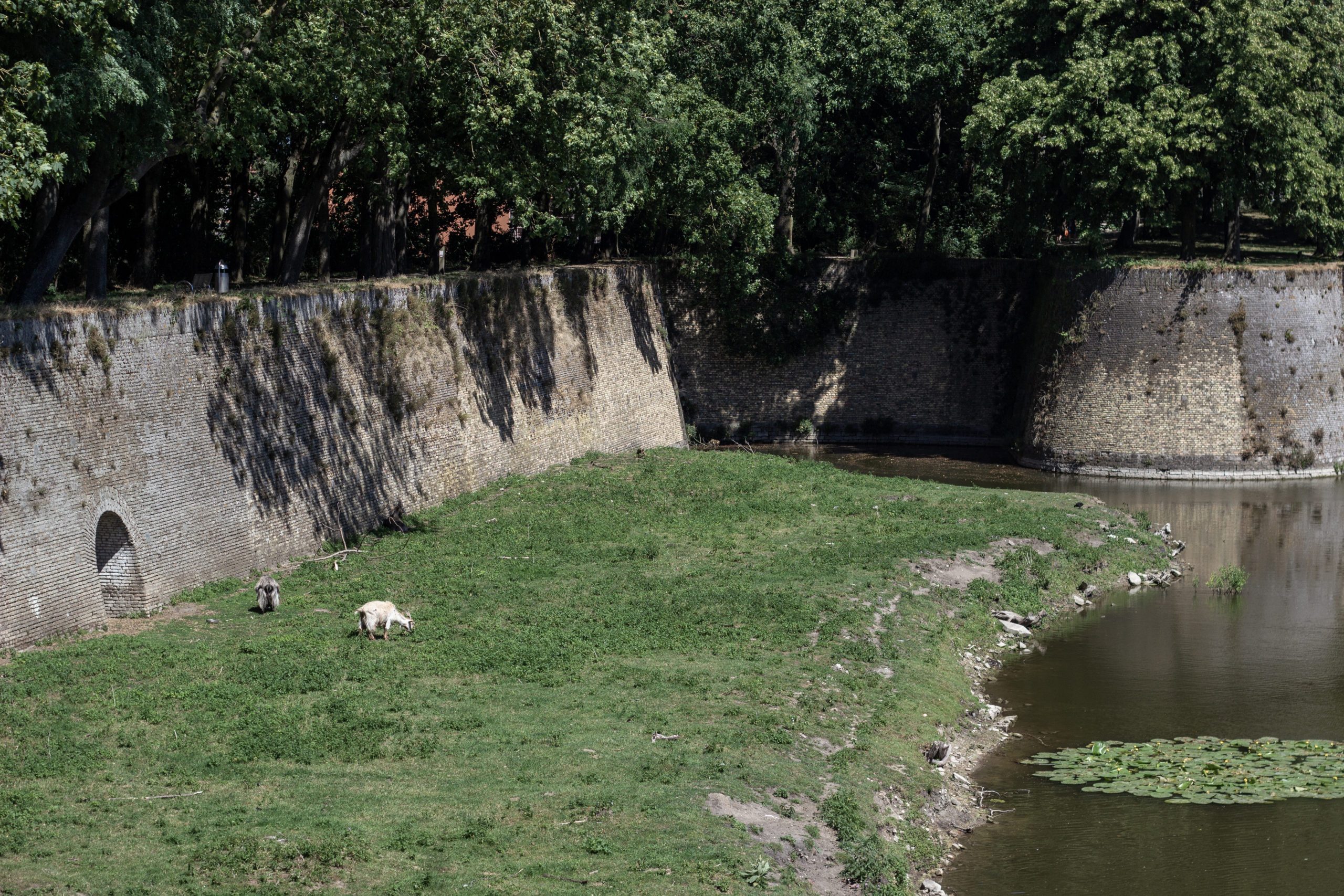
Julie Depypere’s automations at Kazematten meant that when the Covid-19 Pandemic hit, the brewery’s team was perfectly equipped to work remotely during the Lockdowns. “It was like in a glimpse everybody worked from home,” she says. “No problems.” Julie is today focussing on some marketing tweaks and on sales strategy for Kazematten. Her father Hans promoted her to the position of Chief Executive Officer of Brouwerij Sint Bernardus.
Rudi Ghequire is still Mr. Rodenbach, but works closely each week with Koen on production issues and planning. Pre-COVID-19, Rudi was still giving tours to visitors every Saturday afternoon at the Kazematten, despite his travelling around the world with Rodenbach and the time commitment of managing production at Rodenbach’s site in Roeselare. Now facing Lockdown restrictions, he still assists Koen at the Kazematten when he can, bookmarking his visits to Ieper with walks along the historic and nature-filled ramparts above the brewery that his family now co-owns.
Like other aspects of these casemates, the stories of the Wipers Times and the Grotten Santé are interesting not especially for the resulting beers, but for the journeys of the people behind them. By creating a satirical trench newspaper, the Sherwood Foresters sought fulfilment in their lives inside these vaulted chambers by bolstering the spirits of men on the front line of war who were facing possible death. Those involved in the creation of Brouwerij Kazematten today have each found in the casemates some fulfilment on their own personal journeys, whether that’s claiming an identity apart from an institution, making a statement within their own family, or pursuing a way to wholly live all of their passions. When you come across your cave, look deep inside.
*


